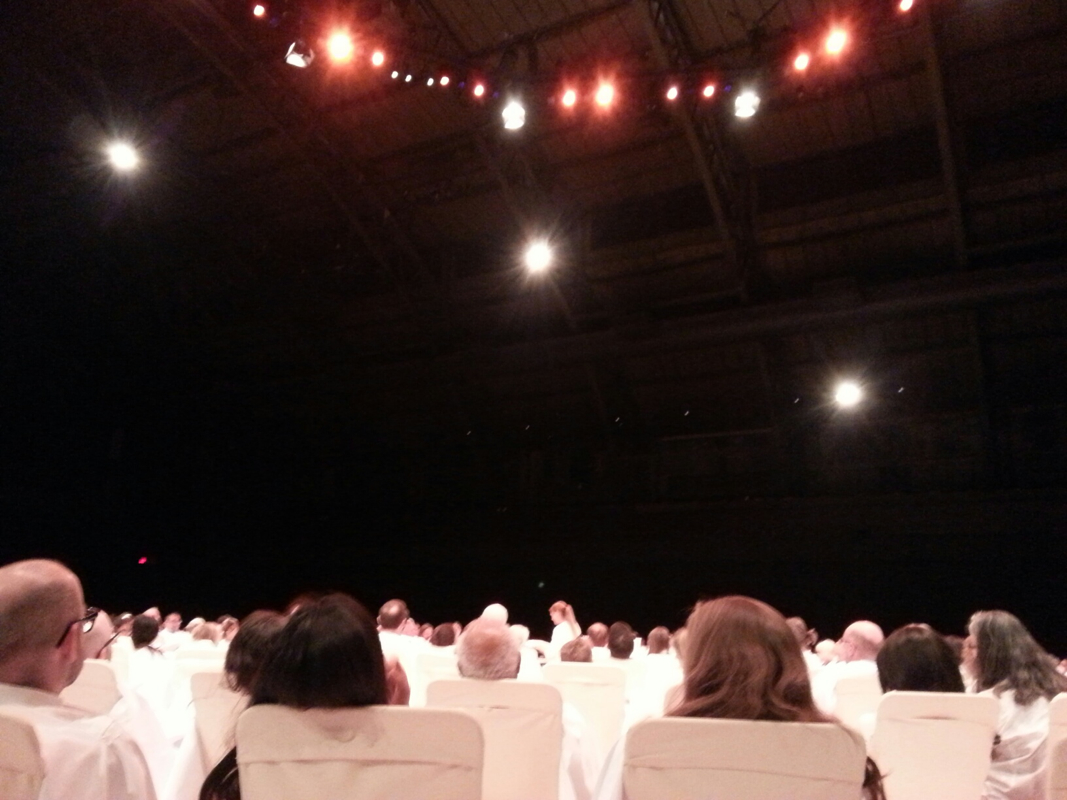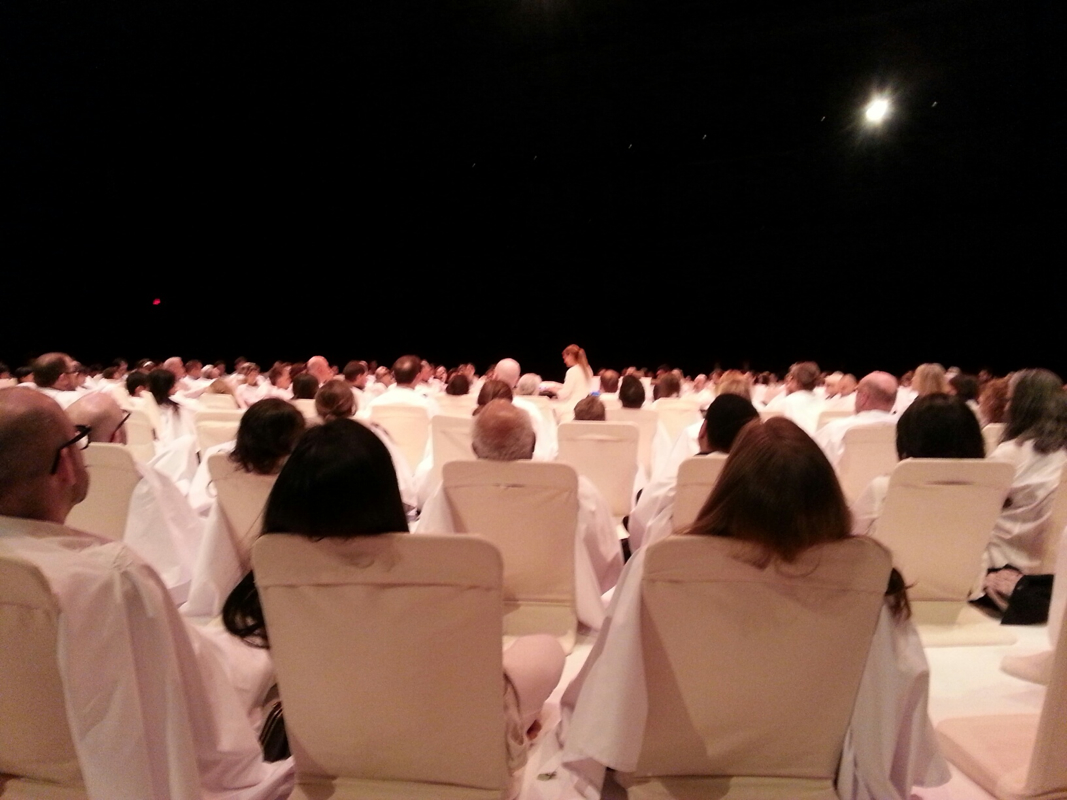My ears are still ringing from the 70-minute Oktophonie performance at the Park Avenue Armory. And as if I have not enough, I am listening to John Cage's Thirteen Harmonies via YouTube. There is some resonance here that I cannot put a finger on. It is as if I can intuit what Cage was trying to say with sound, and what Oktophonie meant with its environment of speakers, tracks and atonal droning. With regards to the performance, I took the advice of a review and listened to the music with my eyes closed. But this was before I considered the "stage" designed by Rirkrit Tiravanija. With composer Karlheinz Stockhausen's references to a lunar surface as the most suitable image to accompany his music, Tiravanija's take with the circular platform, custom-seats that make you stretch your legs on the floor with a back to rest your head to gaze upwards, and the white cape everyone had to wear - was quite clever. It made the circumference of spectators the spectacle, perennially illuminated as we all were with strategically positioned stage lights. While I understood that the smattering of dim-lit lights in the ceiling of the Drill Hall was meant to suggest stars or other celestial objects, and the octagonal frame of spot lights as a sort of moon, I cannot help but consider as well the effect of the architectural trusses that hold up the ceiling as an eerie skeleton of the lunar module and the space station, especially when the lights pass and garish shadows define their lines, bright spiders against the consuming dark.
I tried not to read anything about Oktophonie prior to the performance: now of all instances I am circumspect of all texts framing creative works. But I did encounter the sheet music and a brief video from YouTube and I was piqued with the concept of "sound bombs" that can only be appreciated during a live performance. I actually anticipated these "sound bombs" and I was quite pleased with the experience.
Listening with eyes half-shut (open enough to sense the color of light changing in the performance area) I felt the tension of war, induced by the fields of minor harmonies and the low ominous drone that circled, waned and waxed, like a reconnaissance plane or a bomber making its run over a field about to be blown up. (Later I read that Stockhausen did in fact references bomber planes of WW2!) At first I tried to contain the music in my consciousness - I was scanning textbook descriptions of modern music, etc etc.- but the bombs of sound woke me up to frequent starts. I found Nietzsche's aphorism to be true in this case: music is the most immediate of all the forms of art. I was trying so hard to decode, or encode or to find symbols for the aural environment I was in, quite uncomfortable with the assault on my senses. Then it happened- my consciousness let go and I found myself within the field, reacting not to the "melody" but to the vibrations that took hold of my body. That music is a construct of vibrations is a concept so palpable at that moment, I found all my education in music history as bland as paper: nothing of that mattered here. (Who the hell even thought of writing about art and music this way?)
Oktophonie brought me visions. Spontaneous filaments of dark matter shone radiant against nebulae: I see warring forces as the struggle of stars against one another. Streaks and jets of flame reach out with pointed fingers to the unseen cosmos. And I remember my childhood discovery of the constellations and of the planets. I was seven, and the idea of outer space dislodged God as the object of awe in my head. Religious narratives were far too insular for these space operas. And I never felt the same way again about the night sky. I remember the feeling of trying to express this awe, this childhood wonder, in my sculptures for Astral Projection (2011) and I wonder now if that feeling still lies inexhaustible as I contemplate on what pieces to make for my current residency.
Oktophonie was now nothing but a background of droning sounds: I feel buoyed in the air like in an aircraft. I began to ask: didn't I choose the artistic track over a potential scientific track when I was twelve? The thoughts of space flood my mind and spacecraft flying by the vast vacuum. I remember wanting to meet Michio Kaku the theoretical physicist who teaches at CUNY. Then I resolve back into the present: a sound bomb woke me up from my train of thought. But the music has began to relax, having found its points of unravelling. The teenager on my right jerked her feet and landed on my shin. I saw she was asleep, or have fallen asleep.
An insight: I cannot frame the thoughts of others, no matter how hard I try to construct or research them. The best and only acceptable manner in dealing with others' stories is attention and regard and conscious cognizance. Thus I see a chink in relational aesthetics: the accruing of stories is no different from the curation of rumor. The intervention of the creative project into community serves not the common good, but only the desires of the artist to confer authorship to "someone else" yet stays at the forefront as a steward and as a byline. The events are staged, rigged, to the full effect of making "life" appear when in fact it is the construct of the artist that frames the whole shebang. Its like trying to play chess under a shroud, manipulating the pieces while pretending to be a ghost. So again, the true creative narrative is the one which the artist utters without the mannerism of a subterfuge. A provocateur or a a raconteur is not a creator but a director. But like a Filipino politician, he finds a way to draw the force of the masses to himself. Authorship cannot be denied, but it can be, at all times, hidden occluded. This is the occlusion that I was so wary of and the image from Tiravanija"s octagonal light contraption made me see that.
The music is fading as the light onstage grows brighter. The performer at the center is now visible and the audience raise up their smartphones for a snapshot. I do as well. When the performance concluded I arose like I have just taken a nice nap or did some meditation: it was refreshing. It was validating.
I tried not to read anything about Oktophonie prior to the performance: now of all instances I am circumspect of all texts framing creative works. But I did encounter the sheet music and a brief video from YouTube and I was piqued with the concept of "sound bombs" that can only be appreciated during a live performance. I actually anticipated these "sound bombs" and I was quite pleased with the experience.
Listening with eyes half-shut (open enough to sense the color of light changing in the performance area) I felt the tension of war, induced by the fields of minor harmonies and the low ominous drone that circled, waned and waxed, like a reconnaissance plane or a bomber making its run over a field about to be blown up. (Later I read that Stockhausen did in fact references bomber planes of WW2!) At first I tried to contain the music in my consciousness - I was scanning textbook descriptions of modern music, etc etc.- but the bombs of sound woke me up to frequent starts. I found Nietzsche's aphorism to be true in this case: music is the most immediate of all the forms of art. I was trying so hard to decode, or encode or to find symbols for the aural environment I was in, quite uncomfortable with the assault on my senses. Then it happened- my consciousness let go and I found myself within the field, reacting not to the "melody" but to the vibrations that took hold of my body. That music is a construct of vibrations is a concept so palpable at that moment, I found all my education in music history as bland as paper: nothing of that mattered here. (Who the hell even thought of writing about art and music this way?)
Oktophonie brought me visions. Spontaneous filaments of dark matter shone radiant against nebulae: I see warring forces as the struggle of stars against one another. Streaks and jets of flame reach out with pointed fingers to the unseen cosmos. And I remember my childhood discovery of the constellations and of the planets. I was seven, and the idea of outer space dislodged God as the object of awe in my head. Religious narratives were far too insular for these space operas. And I never felt the same way again about the night sky. I remember the feeling of trying to express this awe, this childhood wonder, in my sculptures for Astral Projection (2011) and I wonder now if that feeling still lies inexhaustible as I contemplate on what pieces to make for my current residency.
Oktophonie was now nothing but a background of droning sounds: I feel buoyed in the air like in an aircraft. I began to ask: didn't I choose the artistic track over a potential scientific track when I was twelve? The thoughts of space flood my mind and spacecraft flying by the vast vacuum. I remember wanting to meet Michio Kaku the theoretical physicist who teaches at CUNY. Then I resolve back into the present: a sound bomb woke me up from my train of thought. But the music has began to relax, having found its points of unravelling. The teenager on my right jerked her feet and landed on my shin. I saw she was asleep, or have fallen asleep.
An insight: I cannot frame the thoughts of others, no matter how hard I try to construct or research them. The best and only acceptable manner in dealing with others' stories is attention and regard and conscious cognizance. Thus I see a chink in relational aesthetics: the accruing of stories is no different from the curation of rumor. The intervention of the creative project into community serves not the common good, but only the desires of the artist to confer authorship to "someone else" yet stays at the forefront as a steward and as a byline. The events are staged, rigged, to the full effect of making "life" appear when in fact it is the construct of the artist that frames the whole shebang. Its like trying to play chess under a shroud, manipulating the pieces while pretending to be a ghost. So again, the true creative narrative is the one which the artist utters without the mannerism of a subterfuge. A provocateur or a a raconteur is not a creator but a director. But like a Filipino politician, he finds a way to draw the force of the masses to himself. Authorship cannot be denied, but it can be, at all times, hidden occluded. This is the occlusion that I was so wary of and the image from Tiravanija"s octagonal light contraption made me see that.
The music is fading as the light onstage grows brighter. The performer at the center is now visible and the audience raise up their smartphones for a snapshot. I do as well. When the performance concluded I arose like I have just taken a nice nap or did some meditation: it was refreshing. It was validating.


 RSS Feed
RSS Feed